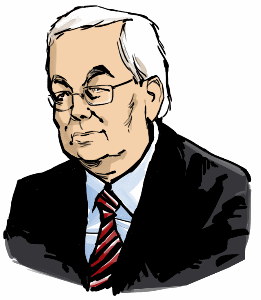Inngangsorð
(Wikipedia)
Thomas Stearns Eliot (1888 – 1965) was an essayist, publisher, playwright, literary and social critic and „one of the twentieth century’s major poets.“ He was born in St. Louis, Missouri to an old Yankee family. However he emigrated to England in 1914 (at age 25) and was naturalised as a British subject in 1927 at age 39.
Eliot attracted widespread attention for his poem The Love Song of J. Alfred Prufrock (1915), which is seen as a masterpiece of the Modernist movement. It was followed by some of the best-known poems in the English language, including The Waste Land (1922), The Hollow Men (1925) […] He was awarded the Nobel Prize in Literature in 1948, „for his outstanding, pioneer contribution to present-day poetry
The Hollow Men appeared in 1925. […] It is Eliot’s major poem of the late 1920s. […]
[A critic] perceived a shift in Eliot’s method, writing that, „The mythologies disappear altogether in The Hollow Men.“ This is a striking claim for a poem as indebted to Dante as anything else in Eliot’s early work […] The „continuous parallel between contemporaneity and antiquity“ that is so characteristic of his mythical method remained in fine form. The Hollow Men contains some of Eliot’s most famous lines, notably its conclusion:
This is the way the world ends
Not with a bang but a whimper.
***
Ég hef lengi haft áhuga á ljóðum T. S. Eliots en, eins og væntanlega flestum öðrum lesendum þeirra, þá var merking þeirra sem lokuð bók fyrir mér. En þó var ég nokkuð viss um að hann þekkti vel til Hamlet mýtunnar í útfærslu Shakespeares og ætti því að hafa verið kunnugur arfleifð Snorra og Sturlu.
Í gær og dag fór ég ítarlega yfir The Hollow Men og The Love Song of J. Alfred Prufrock og athugaði líka Author‘s Notes sem fylgdu The Waste Land. Niðurstaðan er ótvíræð:
Öll þrjú ljóðin byggja á arfleifð Snorra og Sturlu.
Ljóðið The Hollow Men er í fimm hlutum og leiðir síðasti hlutinn til niðurstöðu skáldsins um lok veraldar.
Kjarni málsins felst í samspili hugmynda, orða og tölugilda skv. Táknmálslykli Reykholtsmáldaga og læt ég því allar umsagnir og orðaskýringar liggja á milli hluta hér að neðan.
***
The Hollow Men V
I. Sviðsetning og samantekt
15076 = Here we go round the prickly pear
11122 = Prickly pear prickly pear
15076 = Here we go round the prickly pear
12486 = At five o’clock in the morning.
60167 = Reykholtsmáldagi
11931 = Táknmálslykill Reykholtsmáldaga
1000 = Heimsljós
-4000 = Myrkt Sverð
10900 = Kolr Þorsteinsson
2307 = 23. September
1241 = 1241
7524 = The Second Coming
13159 = Ártíð Snorra fólgsnarjarls
157989
II. Goðsögn Brennu-Njálssögu
6257 = Maðr hét Mörðr
12685 = Höfðingjaskipti varð í Nóregi.
11274 = Fara menn við þat heim af þingi.
13530 = Ok lýk ek þar Brennu-Njálssögu
43746
III. Skuggatilvera (i)
6668 = Between the idea
5793 = And the reality
9496 = Between the motion
3839 = And the act
7917 = Falls the Shadow
10033 = For Thine is the Kingdom
43746
III. Skuggatilvera (ii)
11332 = Between the conception
6542 = And the creation
9724 = Between the emotion
7375 = And the response
7917 = Falls the Shadow
7244 = Life is very long
50134
III. Skuggatilvera (iii)
8540 = Between the desire
5484 = And the spasm
9654 = Between the potency
7358 = And the existence
9211 = Between the essence
5912 = And the descent
7917 = Falls the Shadow
10033 = For Thine is the Kingdom
64109
III (i) – (iii) = 43746 + 50134 + 64109 = 157989.
IV. This is the way the world ends
5608 = For Thine is
2763 = Life is
7135 = For Thine is the
15417 = This is the way the world ends
15417 = This is the way the world ends
15417 = This is the way the world ends
13964 = Not with a bang but a whimper.
The Idea
4177 = Fiat Lux – Verði ljós
Alpha – Formáli Eddu
24844 = Almáttigr Guð skapaði í upphafi himin ok jörð ok alla þá hluti,
24337 = er þeim fylgja, ok síðast menn tvá, er ættir eru frá komnar,
4148 = Adam ok Evu,
22395 = ok fjölgaðist þeira kynslóð ok dreifðist um heim allan.
Omega – Ragnarök
6994 = Örlygsstaðir
-4627 = Veröld Rúms (2312) og Tíma (2315) ei meir/mínus
157989
Viðbót.
Tölugildi texta á Omega blaðsíðu First folio (1623) af leikritum Shakespeares er 1.031.151.
Við frágang á lokatexta The Hollow Men kann T. S. Eliot að hafa tekið mið af þessu tölugildi, sbr.:
1.001.674 = The Hollow Men
11359 = Snorri Sturluson
7524 = The Second Coming
10594 = Sir Francis Bacon, Knight
1.031.151
—
Á Omega blaðsíðu First folio er þessi spásögn:
24167 = When as a Lyons whelpe, shall to himselfe vnknown,
22815 = without seeking finde, and bee embrac’d by a peece of tender Ayre:
21082 = And when from a stately Cedar shall be lopt branches,
18501 = which being dead many yeares shall after reuiue,
20237 = bee iyonted to the old Stocke, and freshly grow,
18503 = then shall Posthumus end his miseries,
22220 = Britaine be fortunate, and flourish in Peace and Plentie.
147525
Sbr. 147525 + 1000 + 4000 + 5464 = 157989, sem tengir Heimsljós, 1000, í mynd Logandi Sverðs, 4000, við verk hins fróða Ara, Íslendingabók, 5464.
Ari, þýðir Ljón/Leo/Lyon á hebresku, og stjörnumerkið Leo hefur um árþúsundir verið tengt Sol Invictus/Heimsljósi.
***
Reiknivél sem umbreytir stöfum í tölugildi er á netinu:
http://www.light-of-truth.com/ciphersaga.htm

 Gunnar Tómasson
Gunnar Tómasson